
Guitar Theory For Dummies
Published by: John Wiley & Sons, Inc., 111 River Street, Hoboken, NJ 07030-5774, www.wiley.com
Copyright 2014 by John Wiley & Sons, Inc., Hoboken, New Jersey
Media and software compilation copyright 2014 by John Wiley & Sons, Inc. All rights reserved.
Published simultaneously in Canada
No part of this publication may be reproduced, stored in a retrieval system or transmitted in any form or by any means, electronic, mechanical, photocopying, recording, scanning or otherwise, except as permitted under Sections 107 or 108 of the 1976 United States Copyright Act, without the prior written permission of the Publisher. Requests to the Publisher for permission should be addressed to the Permissions Department, John Wiley & Sons, Inc., 111 River Street, Hoboken, NJ 07030, (201) 748-6011, fax (201) 748-6008, or online at http://www.wiley.com/go/permissions .
Trademarks: Wiley, For Dummies, the Dummies Man logo, Dummies.com, Making Everything Easier, and related trade dress are trademarks or registered trademarks of John Wiley & Sons, Inc., and may not be used without written permission. All other trademarks are the property of their respective owners. John Wiley & Sons, Inc., is not associated with any product or vendor mentioned in this book.
Limit of Liability/Disclaimer of Warranty: while the publisher and author have used their best efforts in preparing this book, they make no representations or warranties with respect to the accuracy or completeness of the contents of this book and specifically disclaim any implied warranties of merchantability or fitness for a particular purpose. no warranty may be created or extended by sales representatives or written sales materials. The advice and strategies contained herein may not be suitable for your situation. you should consult with a professional where appropriate. neither the publisher nor the author shall be liable for damages arising herefrom.
For general information on our other products and services, please contact our Customer Care Department within the U.S. at 877-762-2974, outside the U.S. at 317-572-3993, or fax 317-572-4002. For technical support, please visit www.wiley.com/techsupport .
Wiley publishes in a variety of print and electronic formats and by print-on-demand. Some material included with standard print versions of this book may not be included in e-books or in print-on-demand. If this book refers to media such as a CD or DVD that is not included in the version you purchased, you may download this material at http://booksupport.wiley.com . For more information about Wiley products, visit www.wiley.com .
Library of Congress Control Number: 2013944338
ISBN 978-1-118-64677-9 (pbk); ISBN 978-1-118-64687-8 (ebk); ISBN 978-1-118-64693-9 (ebk); ISBN 978-1-118-64703-5 (ebk)
Manufactured in the United States of America
10 9 8 7 6 5 4 3 2 1
Introduction
M usic theory is the study of how music works. Guitar theory focuses on understanding music from a guitar players perspective. Makes sense, right? With a good working knowledge of guitar theory, including the use of scales, chords, progressions, modes, and more, you can easily figure out why a song is put together the way it is and how you can improvise and compose your own music.
About This Book
This book aims to explain how you can play popular music on the guitar fretboard, as well as why certain elements of music go together the way they do. Specifically, it covers what types of scale patterns guitarists use and how they form chords, assemble chord progressions, and apply modes.
Note: By popular music, I mean the types of songs you regularly hear on Top 40 and classic rock radio stations, including music by Chuck Berry, The Beatles, Eric Clapton, Led Zeppelin, the Eagles, Guns N Roses, Dave Matthews Band, and U2, just to name a few. Throughout this book, you discover important details of songs like Johnny B. Goode, Purple Haze, Tears in Heaven, Stairway to Heaven, Sweet Child O Mine, With or Without You, and many more.
Instead of taking a traditional approach to music theory, which usually emphasizes reading and writing standard musical notation, this book takes a hands-on approach that emphasizes playing on the guitar fretboard and using guitar tablature and neck diagrams. For example, it shows you how to play scale patterns used for riffing and jamming guitar music, as well as how to build the same chord shapes on the fretboard that famous guitarists use. It also shows you how to play through common chord progressions that you hear in the most popular radio hits. Perhaps most importantly, though, it explains how all these components work together.
With the primary focus being on scales, chords, and progressions, this book doesnt cover much in the way of note reading, rhythm, and technique. It also doesnt teach many of the classic music theory terms and concepts that are normally part of a formal music curriculum. So although you may not be able to pass a music theory exam at a music school after reading this book, you will know how familiar guitar songs are put together and how you can compose and improvise songs on your own.
Rhythm and technique are very important to good guitar playing, but these topics fall outside the scope of this book. If youre new to guitar, you can train your fingers to become a lean, mean guitar-playing machine by working with Guitar For Dummies, Guitar Exercises For Dummies, Rock Guitar For Dummies, Blues Guitar For Dummies, and Classical Guitar For Dummies (all written by Mark Phillips and/or Jon Chappell and published by Wiley). You can also learn about basic rhythms by working with a beginner-level note-reading course like Mel Bays Modern Guitar Method, Hal Leonard Guitar Method, or anything else that is similar.
Heres what sets this book apart from other guitar resource materials:
 The practicality and efficiency of the content: If you dont need to know a certain topic or technique to play guitar and understand popular music, I dont present it here. On the flip side, I cover many concepts that dont typically show up in traditional music theory courses but that are important for guitar players to learn.
The practicality and efficiency of the content: If you dont need to know a certain topic or technique to play guitar and understand popular music, I dont present it here. On the flip side, I cover many concepts that dont typically show up in traditional music theory courses but that are important for guitar players to learn.
 The number of familiar song references: Say goodbye to learning abstract ideas without knowing how they apply to the music you know and love! I refer to some of the most popular songs and famous guitarists of all time in the pages that follow.
The number of familiar song references: Say goodbye to learning abstract ideas without knowing how they apply to the music you know and love! I refer to some of the most popular songs and famous guitarists of all time in the pages that follow.
As you work your way through this book, keep in mind that sidebars and Technical Stuff icons are skippable. A few other things to note are
 All the information applies to both acoustic and electric guitar unless otherwise noted.
All the information applies to both acoustic and electric guitar unless otherwise noted.
 I use six-string guitars and standard tuning in all examples and figures unless otherwise noted.
I use six-string guitars and standard tuning in all examples and figures unless otherwise noted.
 You can apply much of the information in the book to bass guitar, too.
You can apply much of the information in the book to bass guitar, too.
 I use a right-handers perspective throughout the book.
I use a right-handers perspective throughout the book.
 You have to look up and practice popular song references on your own. I dont include the music here.
You have to look up and practice popular song references on your own. I dont include the music here.

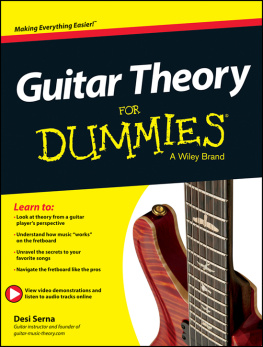
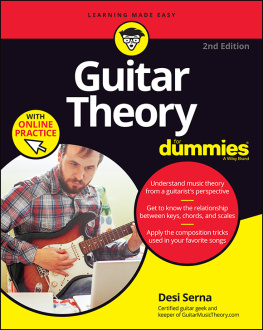




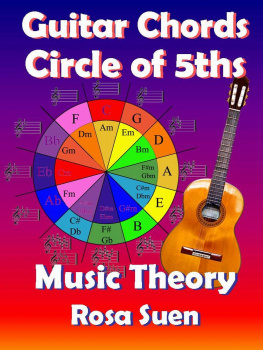
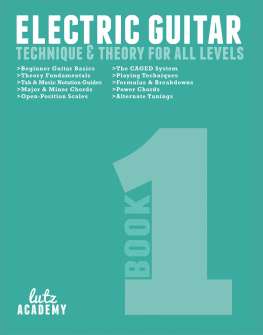
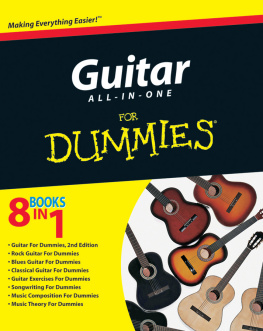


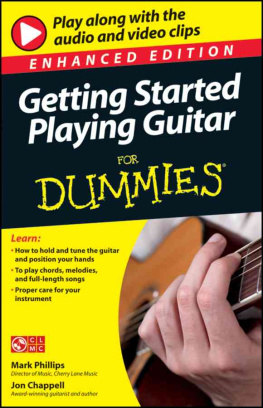



 The practicality and efficiency of the content: If you dont need to know a certain topic or technique to play guitar and understand popular music, I dont present it here. On the flip side, I cover many concepts that dont typically show up in traditional music theory courses but that are important for guitar players to learn.
The practicality and efficiency of the content: If you dont need to know a certain topic or technique to play guitar and understand popular music, I dont present it here. On the flip side, I cover many concepts that dont typically show up in traditional music theory courses but that are important for guitar players to learn.